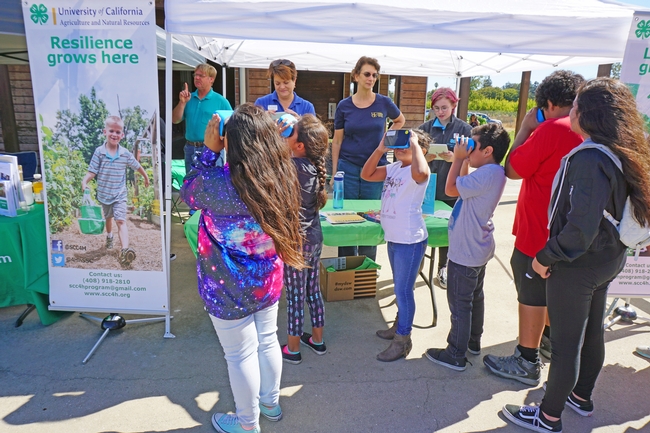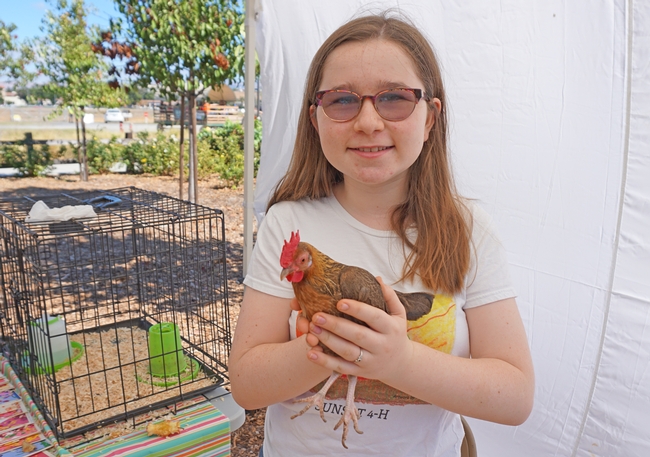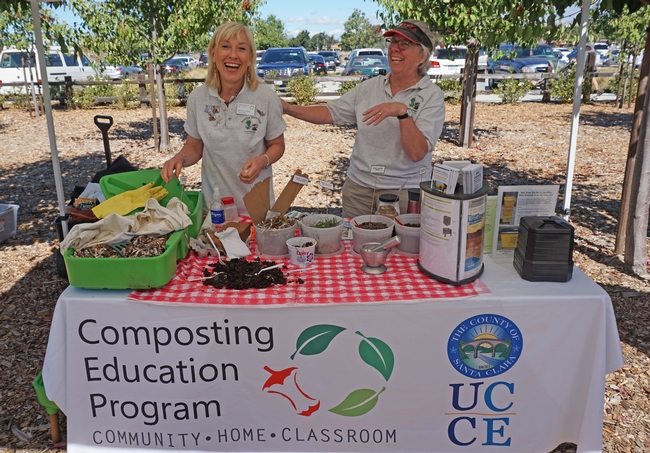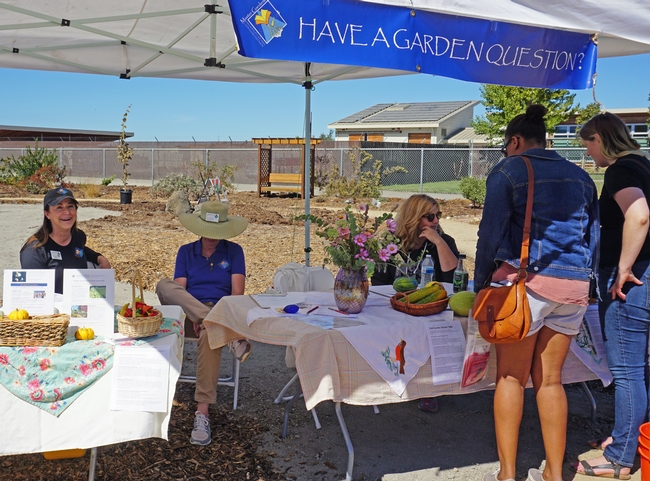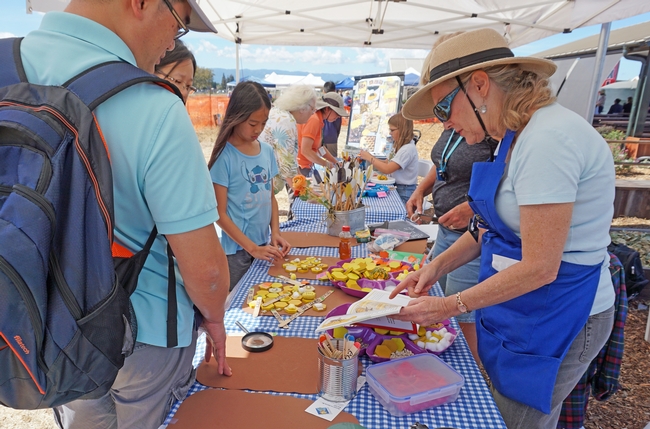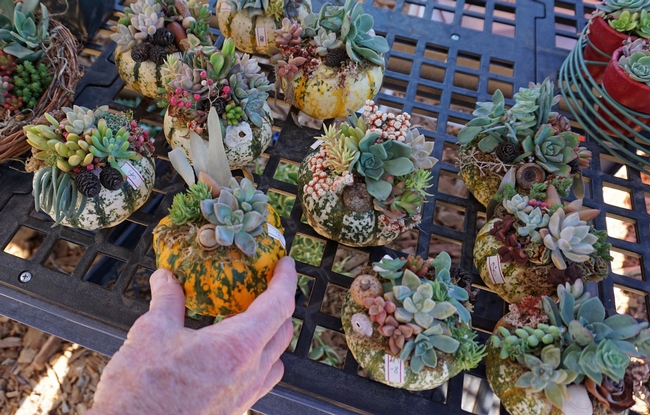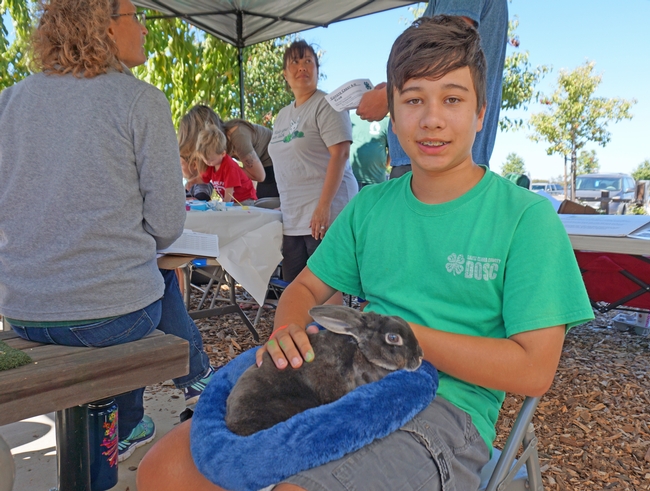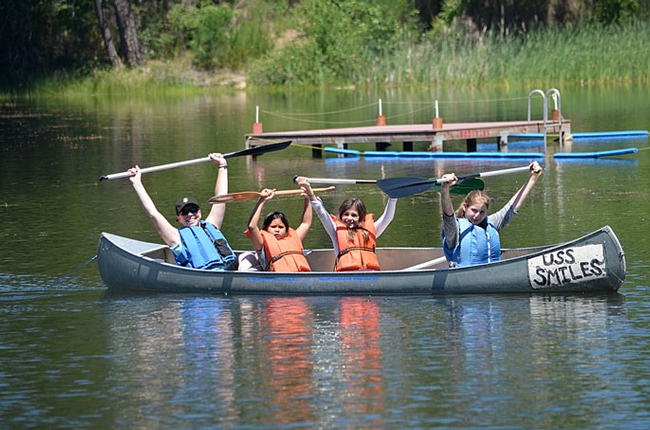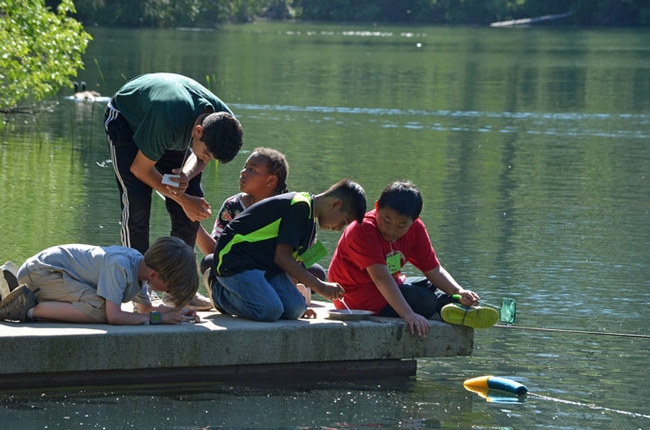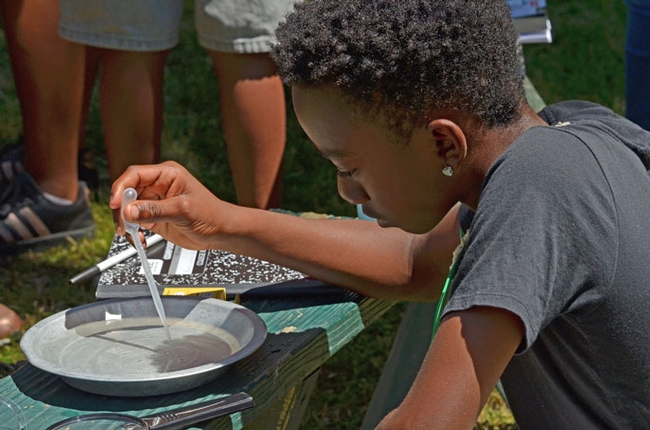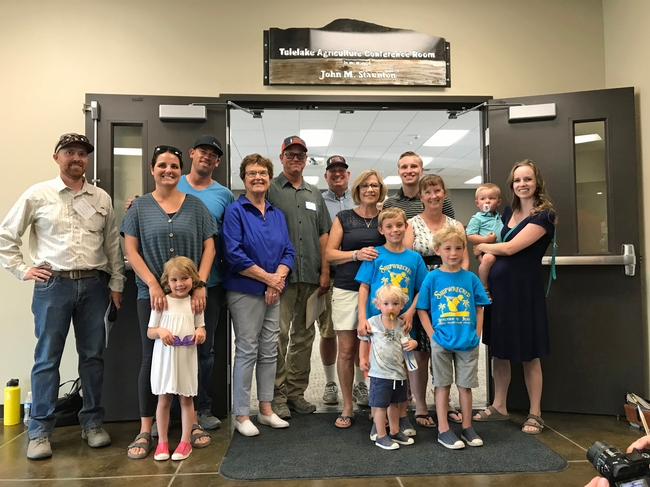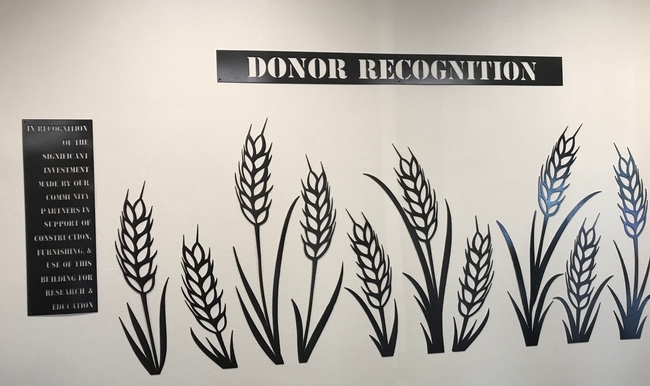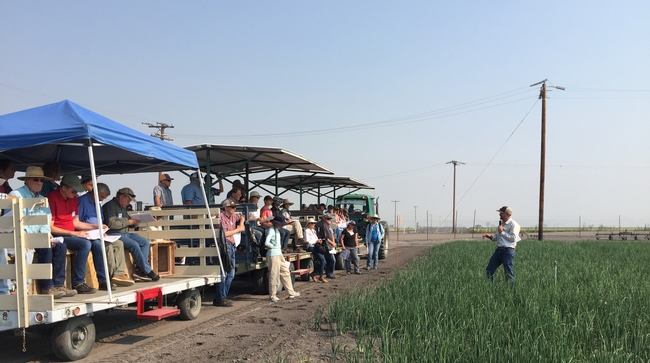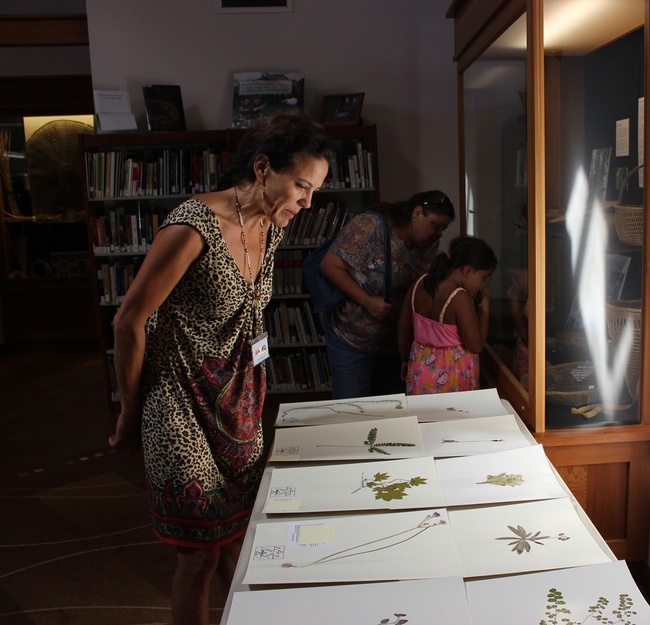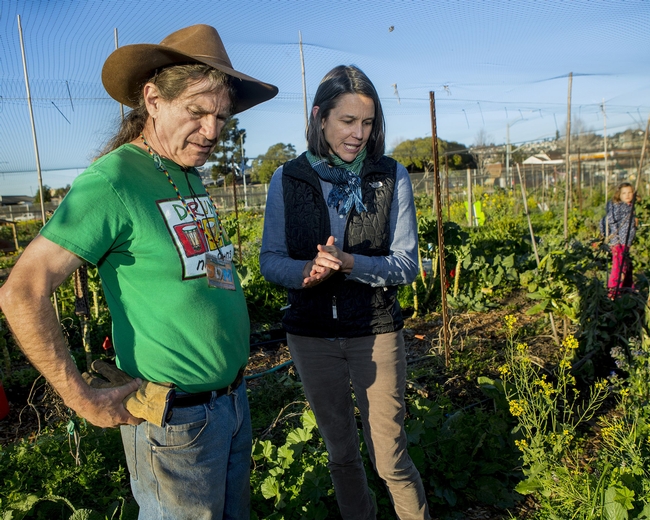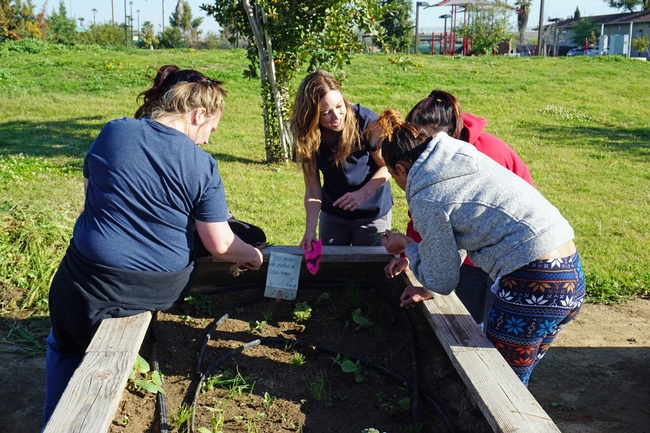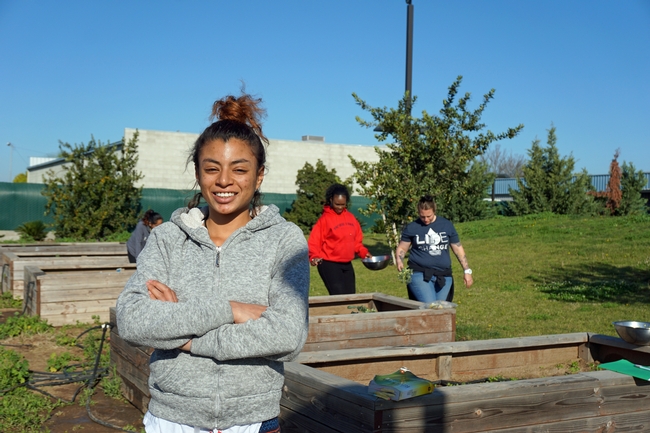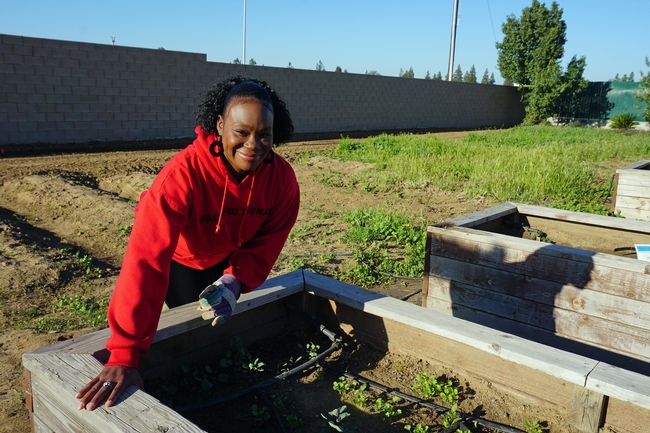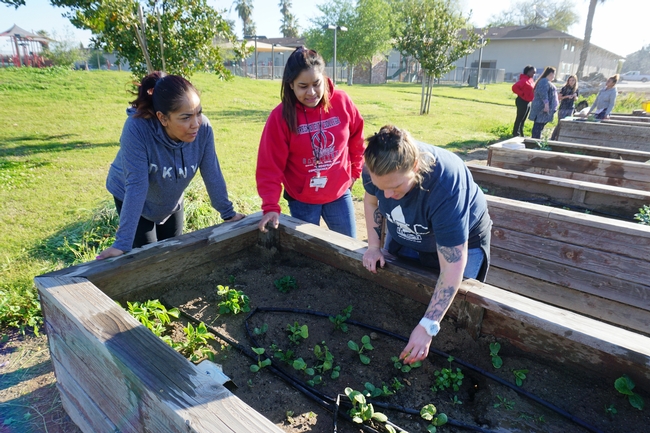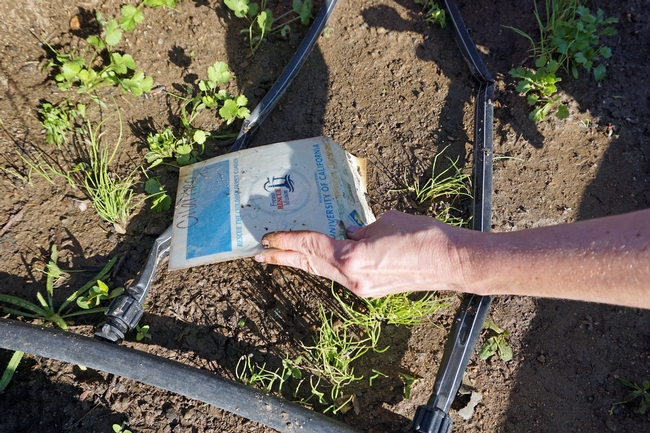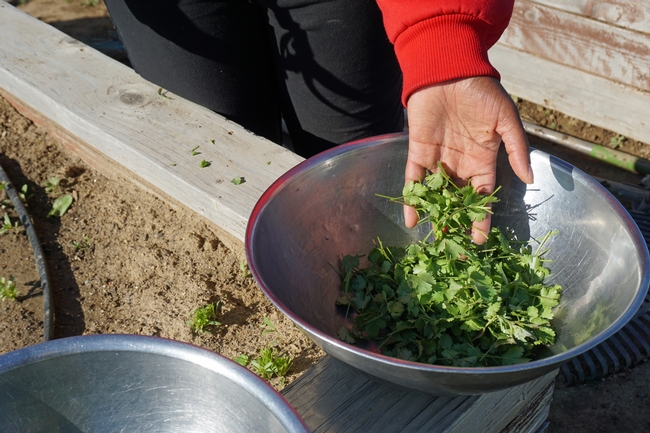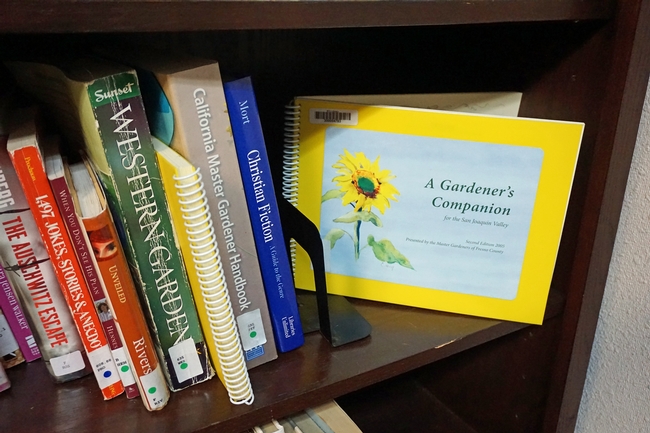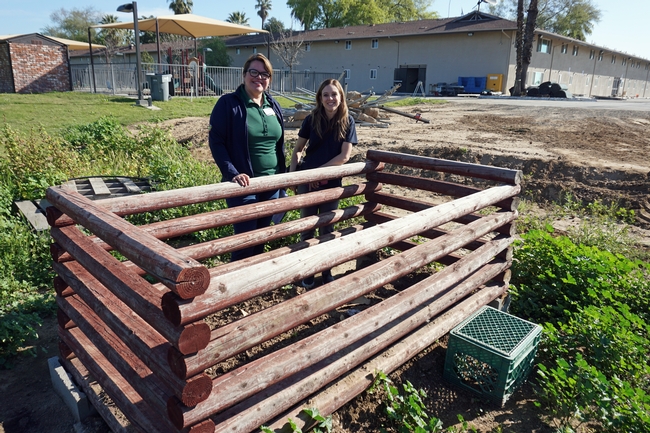- Author: Jeannette E. Warnert
Hands-on crafts, farm animals and fresh organic produce brought the Santa Clara County community to the Martial Cottle Park Harvest Festival in San Jose Oct. 6. UC Cooperative Extension in Santa Clara County participated to share gardening information, composting basics and the fun of 4-H with children and families.
The UCCE 4-H program brought virtual reality goggles that allowed children to look in any direction for a view under the sea, complete with coral, fish and a sea turtle. Santa Clara County 4-H ambassador Alexa Russo used a tablet computer to interact with the children as they looked through the goggles, asking questions to engage them in the experience.
The goggles are just one way 4-H is seeking to light a spark of interest in youth. In clubs throughout the state, 4-H youth are taking part in fun computer science and engineering projects while learning about healthy living, citizenship and leadership.
Booth visitors intrigued by the goggles at the harvest festival were invited to participate in a free event at the Google Mountain View Campus called Code Your World. The activity was developed by 4-H, Google and West Virginia University Extension to teach children about computer science with games and interaction. The Oct. 13 event is being held to to mark 4-H National Youth Science Day.
"Code Your World is fun, hands-on and easy, even for people with no computer science experience," said Fe Moncloa, UC Cooperative Extension Youth Development advisor for Santa Clara County. "We opened Code Your World to all our 4-H members, and we're also encouraging kids who aren't members to come." Space is limited and pre-registration is required. To register, go to: http://ucanr.edu/nysdscc
For more information on Code Your World and the Youth Science Day event, see the Santa Clara County 4-H website.
- Author: Carolyn McMillan
Canoeing on a mountain lake, telling stories around a campfire, sleeping under the stars — it's the quintessential summer camp experience — and for thousands of California kids it's also their first introduction to UC's 4-H program.
And just like the popular program that teaches children to raise and care for animals, 4-H summer camp is as much about leadership training and science education as it is about making new friends and getting out in nature.
“So many of the kids live in the city and for a week they get to escape,” says Tiffany Marino, who joined the Monte Vista 4-H Club in Chino as an 8-year-old and has loved it ever since — especially summer weeks spent at Camp Seely near Lake Arrowhead, with the Los Angeles 4-H program.
The camp is set on a hill with cabins, a fire circle, a mess hall and lodge. There are volleyball and basketball courts, and a pool. “It's all surrounded by trees and greenery. It's so beautiful. It's this one week in summer where everything is OK,” Marino says.
Kids from all over Southern California come to this magical spot, making tight friendships and getting a breather from city life.
But the thing that really makes the camp special is not the setting, Marino said. It's that the teachers and counselors are themselves kids — high schoolers who spend months before camp working together to plan it out, developing educational programming and other fun activities for the week.
A growth experience for teens and campers alike
When summer comes, they put their plans into action, getting first-hand experience teaching classes, leading activities and ensuring that campers have a memorable time.
Adult volunteers keep an eye on things, but the teens themselves run the show, said UC Cooperative Extension's Keith Nathaniel, the Los Angeles county director & 4-H youth development advisor.
Along with archery, nature walks, swimming and other traditional camp activities, the teens hold science-based classes that challenge campers to work in teams to come up with solutions for things like how they would improvise a shelter to get out of bad weather.
“The teens come up with the activities,” says Nathaniel. “It's an applied experience where they get to use the leadership skills they've developed in a really meaningful way.”
Building confidence
Rose Clara and Connor Gusman, rising seniors at C.K. McClatchy High School in Sacramento, have both spent time as teen leaders with On the Wild Side, a 4-H camp that brings fourth through sixth graders from disadvantaged communities out for a weekend in the mountains near Nevada City.
The goal is to give campers a chance to explore and learn about the natural world in a way that is fun and builds confidence.
“The kids are so excited to be on a camp-out, but sometimes they are sort of scared too — for some of them, it's their first time away from home,” Clara said. “It's super cute to see how excited they are by everything. By the end of camp, they're hugging you and crying and they give you their name tag so you'll remember them.”
Clara helps her young campers quickly feel at home by playing an icebreaker, like the game where each person names a favorite thing — maybe a food or an animal — and everyone else who likes that same thing steps into the circle with them.
“It's a way to unite everyone,” Clara says.
‘You can inspire someone and cause a change'
Both she and Gusman discovered that they liked teaching and bonding with the kids so much that they went from being camp counselors to joining the program development committee, a team that chooses the curriculum and plans the whole camp.
Gusman even helped write a grant that secured $500 from the Sacramento Region Community Foundation to help off-set the cost of buses and meals for the campers.
“Most of the kids haven't been outside Sacramento. They haven't seen the stars or had a camp experience before,” Gusman said. “They always love the campfire and the songs.”
One of his biggest surprises was learning how much of an impact he could have as a teacher.
He used the small lake by the camp to show the kids how to assess water quality, including analyzing the prevalence of indicator species that can tell you if the water is clean and healthy.
“Going through the process of developing the lesson, I wasn't totally hooked until we were at camp. There was one really shy girl who on the first day said, ‘I don't like science.' Then at the end, she was like, ‘I really loved it and I'm going to take as many science classes as I can,'” Gusman said.
“I wasn't a pessimist before, but I also wasn't super positive that there was a magical moment when you could inspire someone and cause a change. The camp has shown me that you can do that. You can help other people grow to love science and the earth, and see them grow like that.”
Cultivating citizens
Marianne Bird, the 4-H youth development advisor in Sacramento County who oversees 4-H On the Wild Side as part of her work with UC Cooperative Extension, said that teens are particularly effective as teachers.
“They have a rapport with the little kids that as adults we don't always have,” Bird said.
Both she and Nathaniel evaluate the camps once they end, and survey both participants and teen leaders about their experiences. The responses on both sides are overwhelmingly positive.
One of the questions they ask the teenage teachers is whether they feel that they've made a contribution to their community, Bird said.
“That's a big part of 4-H — citizenship. Not just voting, but being a part of your community and believing that you can make a difference on issues that are important to you.”
The proof comes in seeing how these young leaders grow and change from their experiences.
A lasting legacy
Rose Clara, for instance, knew she liked teaching before she started volunteering with 4-H, but the camp experience has given her a new passion for advocacy and political science. She has joined the California Association of Student Councils and used her newfound leadership skills to host a mental health awareness week at her school.
“I think that comes from 4-H — stepping up like that. I want to help people,” Clara said.
Marino, who as the youth director was in charge of the entire week at Camp Seely last year, says simply of 4-H:
“It has taught me so much and given me everything: leadership skills, people skills, role models.”
At 19, she has now reached that bittersweet moment where she has “aged out” of 4-H. But through its programs, she learned to raise and show animals, came to understand civics through trips to Sacramento, and developed her leadership skills and style.
A sophomore majoring in business at Cal Poly Pomona, 4-H has taught her that she can succeed.
“It's definitely given me lots of confidence and substance — I know that I am capable.”
This article courtesy of the UC Office of the President.
View a video about 4-H Summer Camp:
- Author: Pamela Kan-Rice
Intermountain Research and Extension Center (IREC) celebrated the grand opening of a multipurpose conference and laboratory building on July 26, 2018. The facility is available for use by private and public groups for business meetings, job fairs, trainings and conferences.
"The facility is the first in the Tulelake area to offer modern audio-visual infrastructure and high-speed internet connectivity capable of supporting remote presentations to stay in touch with groups from around the world," said Rob Wilson, IREC director. "We hope this facility will greatly increase the visibility and accessibility of local events and help draw more regional attention to the area."
The conference room was dedicated in honor of the late John Staunton, a local research collaborator with UC Agriculture and Natural Resources who passed away in 2015. Staunton Farms and the Staunton family donated $25,000 to support the building project and recognize the Tulelake farmer and his long-standing support of agriculture and research.
Winema Elevators/Western Milling, Sensient Natural Ingredients, Macy's Flying Service, and Basin Fertilizer also contributed support.
UC awarded approximately $2 million for this capital improvement project with funds from UC lease revenue bonds to pay for most of the building's design and construction costs, but additional support is needed to complete the project. Intermountain REC has set a fundraising goal of $100,000 to pay for tables, chairs, furnishing and lab equipment for the building.
A special UC fund has been created to collect tax-deductible contributions to be used solely for this building project. Donations over $50 will receive recognition in print and on the IREC website. Donations over $1,000 will receive recognition on the donor wall in the building entryway. Name plate recognition on the donor wall will be based on the gift amount: Gold ($2,500+), Silver ($1,750 to $2,499), and Bronze ($1,000 to $1,749). Donations can be made via check using the enclosed envelope or by credit card by visiting the IREC website at http://irec.ucanr.edu and clicking the “Make a gift” link.
Research conducted at Intermountain REC includes biological control of cereal leaf beetle, influence of fall harvest management of irrigated grass hays, onion white rot, managing alfalfa weevil and clover root cucurlio, pulse crop options for the Klamath Basin, cover crops and amendments, cutting schedule effects on low lignin alfalfa and germplasm evaluation of alfalfa and tall fescue.
- Editor: Julie Gipple
- Author: Nate Seltenrich
Jennifer Sowerwine helps restore culturally relevant food systems to immigrant and Native American populations
The Karuk Tribe once lived on more than a million acres in remote Northern California. Legally, their ancestral land along the middle section of the Klamath River in Siskiyou County was in the public domain, as the Karuk did not have a reservation. But on May 6, 1905, when President Theodore Roosevelt created the Klamath Forest Reserve, the tribe lost any claim to its aboriginal territory.
Less swiftly but just as conclusively, the tribe also lost access to much of what the rivers and mountains provided: deer and elk, salmon, tan oak acorns, mushrooms, berries, medicinal herbs. And it lost its ability to manage the landscape through prescribed fire in order to ensure the survival of the plants and animals it needed. The Karuk's food system had been broken almost overnight, and has yet to recover. But Jennifer Sowerwine — UC Cooperative Extension specialist in the UC Berkeley College of Natural Resources — believes it still can.
In direct collaboration with Karuk tribal leaders and community members, as well as with the nearby Yurok and Klamath Tribes, Sowerwine has helped put millions of dollars from USDA to work restoring food security — defined as access to sufficient, healthy, and culturally appropriate foods — among those from whom it was once taken.
While this is a challenge to which one could easily dedicate a career, Sowerwine's broader mission to support equitable food systems across the state has also led her to other projects and other communities. In the Central Valley, she has spent years working with Southeast Asian farmers. Closer to home, she recently began studying how community farms and gardens improve food security among at-risk populations in the urban East Bay.
Restoring ancient relationships to food
Sowerwine's body of work is a manifestation of the University of California Cooperative Extension's long-standing mandate to aid the “welfare, development, and protection of California agriculture, natural resources, and people.” CNR is the home of Cooperative Extension at UC Berkeley, which — now celebrating 150 years since its founding as a land-grant university — is intended to benefit all residents of our increasingly populous and diverse state.
That includes California's first residents: Native tribes like the Karuk, the Yurok (located along the lower stretch of the Klamath River), and the Klamath (upriver, across the border in Oregon). All three were traditionally non-agrarian, hunter-gatherer communities. Loss of ancestral lands that had sustained them for millennia affected not only their diet — leading to a reliance on institutional and heavily processed foods that have contributed to persistent health problems —but also their culture.
In working with the tribes, Sowerwine first had to listen.
“One of the main philosophical approaches in my work is to collaborate with the community to identify what the problems are, co-create research questions, and then support, on the extension side, the kinds of programs they need to attain their goals,” she said.
Among the Karuk, the tribe with which Sowerwine works most closely, “the community is actively engaged in exploring ways to revitalize their eco-cultural system,” she said. “That includes managing the landscape with traditional methods to improve the productivity and availability of cultural foods and fibers, and restoring some of the relationships around Traditional Ecological Knowledge (TEK).”
Beginning in 2012, through a five-year, USDA-funded grant, Sowerwine partnered with all three tribes to help them reclaim control over their food systems using a holistic, community-centered approach. This took a variety of forms, including designing K–12 curricula for local schools around traditional food systems; opening two new herbaria to preserve and share specimens of native food plants; hosting workshops on subsistence skills like butchering, bread making, and canning; and finding appropriate ways of reintroducing sustainable local agriculture into communities for whom traditional farming is linked with colonialization.
This work now serves as a model for tribes across the country.
“There's a lot of interest in all of our programs,” says Karuk tribal member and Pikyav Field Institute program manager Lisa Hillman. In particular, the tribe created a digital library to offer easy access to information about traditional foods and ecological knowledge, which has attracted significant acclaim and earned Hillman invitations to discuss it at national conferences. “Working with [Jennifer] opened a whole lot of doors for our tribe,” Hillman says. The project's success also led to a second, three-year USDA grant that should continue to point the way forward and help mitigate some past harms for the Karuk Tribe.
Interventions for Southeast Asian refugee farmers
Sowerwine began her career studying food security among marginalized residents of a very different part of the world, who nonetheless have much in common with her current collaborators. As a doctoral candidate in the Department of Environmental Science, Policy, and Management (ESPM) at Berkeley, she spent two years in the highlands of Vietnam learning how land-use laws and economic policies affected indigenous local farmers from the Mien minority ethnic group and their ability to sustain agrarian practices that were vital to their culture and food security.
After earning her PhD, Sowerwine continued at Berkeley as a postdoctoral researcher. A vibrant community of Mien immigrants exists not far away, in Sacramento, where refugees of the Vietnam War first arrived from Laos in the late 1970s. They were joined by fellow refugees from the Hmong ethnic group, many of whom settled in Fresno. Both groups had traditionally worked the land in Southeast Asia, and they soon developed robust farming networks here in California.
Using a proficiency with the Vietnamese language honed overseas, Sowerwine initially set out to assess the productivity and economic viability of these small farms operated by Southeast Asian refugees.
“I wanted to understand the barriers they were facing in terms of farming in the Central Valley of California, which is arguably the most industrialized agricultural landscape in the world,” she said.
Approximately 100 Mien farmers — part of a Sacramento-area Mien population of about 15,000 — work small plots of land, averaging about eight acres each, outside the state capital. They primarily grow strawberries to sell at roadside stands, but also produce a wide variety of traditional foods, like “sticky” corn, yu choy, gai lan, purple long beans, and bitter melon — mostly for home consumption.
Hmong farmers, who are concentrated in Fresno and Sacramento counties, grow conventional vegetables like cherry tomatoes, green beans, onions, and lettuce — in addition to their own cultural and traditional foods — to sell at farmers markets, Asian grocery stores, and wholesale markets.
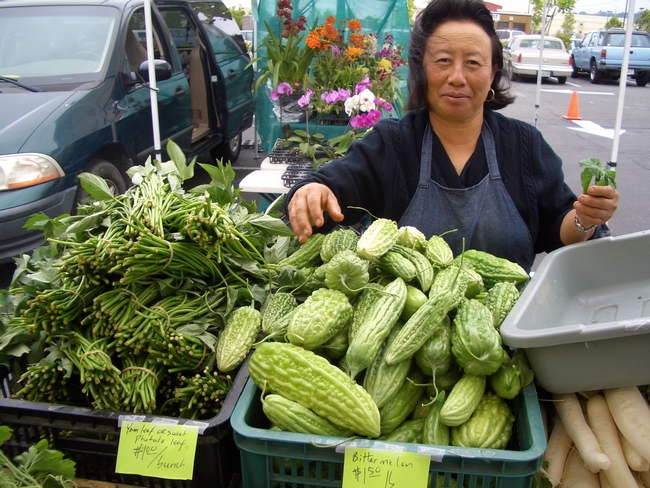
The two groups' successes have not come easy, owing to such challenges as language barriers, differences between traditional and modern farming techniques, and informal labor practices that often clash with state regulations.
In response, Sowerwine designed and led an array of interventions to support the farms' continued viability. These included offering hands-on, native-language training to help Hmong and Mien farmers comply with complex labor and food-safety regulations; teaching farmers how to achieve organic certification or to make and sell “value-added” foods like jams; and providing assistance in accessing new markets for fresh produce, including schools, farmers markets, and wholesalers.
Throughout her career, Sowerwine has worked closely with UC Cooperative Extension advisors around the state, including Richard Molinar — a now-retired small farms and specialty crops advisor in Fresno County — and his successor, Ruth Dahlquist-Willard.
“We accomplished a lot, and we helped hundreds, if not thousands,” Molinar said.
Protecting farmers' livelihoods is only the start, Sowerwine notes. Positive outcomes ripple out to the broader immigrant community, which sees strengthened food security through a steady supply of affordable, culturally appropriate produce, and to the entire regional economy and food system, which benefit from a robust and diverse network of local food producers.
“The land-grant universities were founded for the ordinary people, and not just the elite,” Dahlquist-Willard said. “The original idea was to provide support and training for people in professions like agriculture. It's part of the health of rural communities.”
The power of small-scale urban agriculture
Yet as Sowerwine's work in the East Bay has shown, small-scale agriculture can also be critical to the health and well-being of urban residents — especially recent immigrants. In 2016, she and a team of 12 undergraduate research assistants surveyed more than 100 community, school, and for-profit farms and gardens between Hayward and Richmond. A dozen of the community gardens were included in a subsequent pilot study to learn more about how urban farms can provide immigrants with reliable access to affordable traditional foods.
Despite a combined area of just 10.5 acres, these plots were producing more than 300 distinct crops. Many of these plants have direct ties to specific culinary and medicinal traditions, including nine varieties of edible cactus used for nopales (cactus pads) and tuna (cactus fruit) in Mexican cuisine, and even as a diabetes remedy; gandana, also known as Afghan leek, a critical ingredient in the traditional dishes bolani and ashak; and chinsaga (Cleome gynandra), a plant used by Kenyan women for postpartum healing and infant health.
Late last year, in collaboration with the Berkeley Food Institute, Sowerwine received a grant from the national nonprofit Foundation for Food and Agriculture Research to further promote and study Bay Area urban farming. Along with ESPM faculty members Timothy Bowles and Céline Pallud, as well as Charisma Acey from the College of Environmental Design, she'll delve even deeper into urban agriculture across the Bay Area.
The team plans to address a diverse and thought-provoking array of questions, most of which have never been studied so thoroughly in the Bay Area. For example, what is the role of urban farms in supporting beneficial insects and improving soil health? How does food from urban farms find its way to consumers and how can waste along the way be minimized? What cultural or structural barriers may prevent locals from accessing urban-farming products?
As with all of Sowerwine's work, from the Oregon border to the East Bay, the goal is not simply to learn more, but to make a difference.
“There's a need to elevate an understanding of the value and importance of these spaces to local, state, and national government, to figure out ways of securing them for the long-term benefit of our diverse California public,” Sowerwine said. “The goal is to inform policy and create opportunities for tribal communities and small-scale family and urban farmers, to maintain the continuity of their cultural food heritages.”
- Author: Jeannette E. Warnert
Nutrition education has stretched into a garden at a Fresno facility where women are putting their lives back together.
The UC Cooperative Extension UC CalFresh nutrition education program in Fresno offers its five-week series “Plan, Shop, Save and Cook" at Rescue the Children, a residential program where women who were abused, homeless, previously incarcerated or faced other challenging life circumstances stay for 18 months to learn life and job skills, plus nurture their spirituality.
Rescue the Children is a program offered by the Fresno Rescue Mission. Women with young children or without are referred by such agencies as child protective services, the county probation office and courts. The women make a personal commitment to stay for a year and a half.
“We're not a shelter where they come and go,” said Priscilla Robbins, Rescue the Children director. “We're a ministry.”
Rescue the Children is a safe place for women to get away from destructive lifestyles, where they can heal, learn, grow and become productive members of society.
UC CalFresh reaches out to a variety of community programs and schools with nutrition, garden and physical activity education to teach recipients of CalFresh (formerly called food stamps) and those who are eligible for CalFresh how to make safe, healthful and budget-friendly dietary and cooking decisions. CalFresh benefits – which are part of USDA's Supplemental Nutrition Assistance Program – can be used to buy food, edible garden transplants and vegetable seeds.
During a nutrition education session last year, one Rescue the Children resident asked whether an unplanted garden area in the facility could be restored to grow vegetables, said Nancy Zumkeller, UC CalFresh nutrition educator. As a UC Cooperative Extension program, it was easy to connect with the UC Master Gardeners and collaborate to provide garden and nutrition education.
Several Master Gardener volunteers and the UC CalFresh garden team provided classroom gardening training and worked with the women to clear weeds, update irrigation, and sow seeds and transplants in four raised-bed plots.
The Master Gardeners donated gardening books to the Rescue the Children library, including the Master Gardener Handbook, a definitive guide to environmentally sound gardening practices with chapters on soil, fertilizer and water management, home vegetable gardening, and detailed information on number of specific garden crops.
As part of their structured schedule of classes, work, meals and Bible study, the women spend one hour each Wednesday working in the garden, a time that residents have come to relish.
“Aunty Shirley had a garden in Madera,” said Debriana*. “I would go and help her. It's a soothing process.”
Adriana said she values her new gardening knowledge.
“This is a great experience for learning the skills for outside life,” she said. “It will be a complete transformation from where we came from.”
Resident Darcy has lived at the facility for nine months, and been involved with the garden for six months' time.
“It's nice to watch things grow. It feels successful,” she said. “You plant all this stuff and there's nothing there. You come out a couple weeks later and, oh my gosh, my box is growing all this stuff. It's very cool to be able to learn these tools. When we go out on our own and have our own place, we can grow our own fruits and vegetables.”

